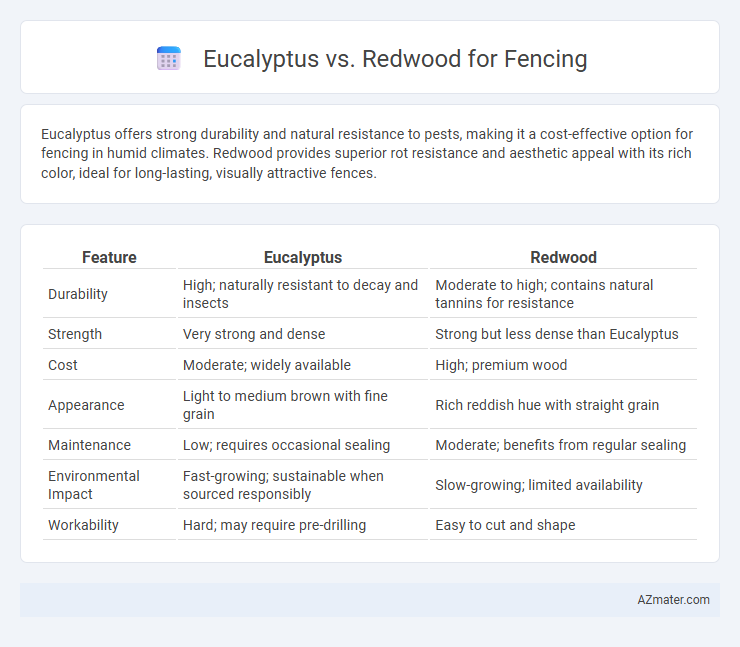Eucalyptus offers strong durability and natural resistance to pests, making it a cost-effective option for fencing in humid climates. Redwood provides superior rot resistance and aesthetic appeal with its rich color, ideal for long-lasting, visually attractive fences.
Table of Comparison
| Feature | Eucalyptus | Redwood |
|---|---|---|
| Durability | High; naturally resistant to decay and insects | Moderate to high; contains natural tannins for resistance |
| Strength | Very strong and dense | Strong but less dense than Eucalyptus |
| Cost | Moderate; widely available | High; premium wood |
| Appearance | Light to medium brown with fine grain | Rich reddish hue with straight grain |
| Maintenance | Low; requires occasional sealing | Moderate; benefits from regular sealing |
| Environmental Impact | Fast-growing; sustainable when sourced responsibly | Slow-growing; limited availability |
| Workability | Hard; may require pre-drilling | Easy to cut and shape |
Introduction: Eucalyptus vs Redwood Fence Comparison
Eucalyptus and Redwood are popular choices for fences due to their natural durability and aesthetic appeal. Eucalyptus offers fast growth and resistance to decay, making it a cost-effective option, while Redwood provides exceptional stability, rich color, and resistance to insects. Choosing between Eucalyptus and Redwood depends on factors like budget, climate, and desired fence longevity.
Durability and Longevity
Eucalyptus and Redwood are both popular choices for fencing, with Redwood generally outperforming Eucalyptus in durability and longevity due to its natural resistance to decay, insects, and warping. Redwood's high tannin content provides extended protection, resulting in fences that can last 20-30 years or more with proper maintenance, while Eucalyptus typically offers a lifespan of 10-15 years, requiring more frequent treatment to prevent rot and pest damage. Choosing Redwood is optimal for long-term fence durability, especially in climates prone to moisture and insects.
Weather Resistance and Climate Suitability
Eucalyptus wood offers excellent weather resistance due to its high density and natural oils, making it suitable for humid and rainy climates where moisture and decay are concerns. Redwood is renowned for its inherent resistance to rot and insect damage, thriving particularly well in moderate to dry climates with less extreme temperature fluctuations. Both woods provide durability for fencing, but eucalyptus performs better in wet environments, while redwood excels in areas with seasonal dryness and consistent mild weather.
Maintenance Requirements
Eucalyptus fences require regular maintenance to prevent warping and cracking due to their high moisture content, necessitating frequent sealing or staining every 1 to 2 years. Redwood fences demand less upkeep because of their natural resistance to decay and insects, often only needing sealing or staining every 3 to 5 years to maintain appearance and durability. Both woods benefit from proper installation and occasional cleaning to extend lifespan and preserve structural integrity.
Aesthetic Differences
Eucalyptus fences showcase a rich, warm reddish-brown color with a smooth grain pattern that can darken over time, providing a rustic, natural appearance ideal for a Mediterranean or earthy style. Redwood fences offer a distinctive deep red to pinkish hue with prominent, straight grain lines that maintain their brightness longer when properly treated, lending a classic and elegant look suitable for traditional or coastal aesthetics. Choosing between eucalyptus and redwood depends on desired color stability and the visual texture that complements the surrounding landscape.
Environmental Impact and Sustainability
Eucalyptus fences demonstrate strong environmental sustainability due to the tree's rapid growth and ability to sequester carbon efficiently, reducing overall carbon footprints compared to slower-growing redwood. Redwood, while naturally resistant to decay and pests, often involves harvesting from old-growth forests, which raises concerns about deforestation and habitat loss. Eucalyptus offers a more renewable option with shorter harvest cycles and lower ecological disruption, making it a preferred choice for eco-conscious fencing projects.
Cost Comparison
Eucalyptus fences generally cost less due to the wood's faster growth rate and widespread availability, making it a budget-friendly option for fencing projects. Redwood fences, while pricier upfront, offer greater durability and natural resistance to decay and insects, often extending the fence's lifespan and reducing long-term maintenance expenses. Homeowners should weigh initial installation costs against potential longevity benefits when choosing between eucalyptus and redwood fencing materials.
Installation and Workability
Eucalyptus offers high density and durability, making it resistant to rot and insects, but its hardness can challenge installation with standard tools. Redwood is softer and easier to cut or nail, facilitating quicker, more precise fence assembly and reducing labor time. Both woods require pre-drilling for screws; however, redwood's stability and uniform grain enhance workability, while eucalyptus often demands more specialized handling due to its toughness.
Pest and Rot Resistance
Eucalyptus offers strong natural pest resistance due to its high oil content, making it less susceptible to termites and wood-boring insects compared to many other woods. Redwood is renowned for its exceptional rot resistance, as its natural tannins and extractives protect it from decay and fungal growth in damp conditions. While both woods provide durability, redwood generally performs better in regions with high moisture levels, whereas eucalyptus is advantageous in areas prone to insect activity.
Final Verdict: Which is Better for Fencing?
Eucalyptus offers high durability and natural resistance to decay, making it a cost-effective option for long-lasting fences with minimal maintenance. Redwood provides superior aesthetic appeal and excellent resistance to insects and moisture but comes at a higher price point. For fencing, Eucalyptus balances strength and affordability, while Redwood excels in beauty and longevity, making the choice dependent on budget and design preferences.

Infographic: Eucalyptus vs Redwood for Fence
 azmater.com
azmater.com